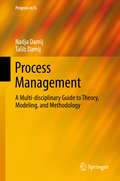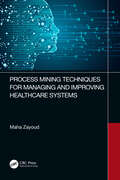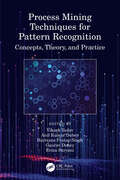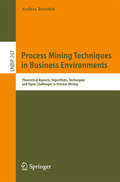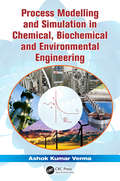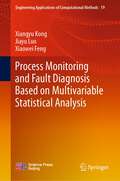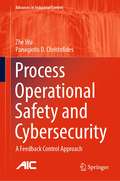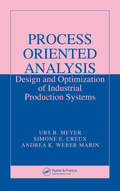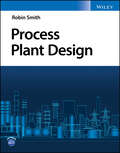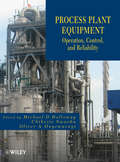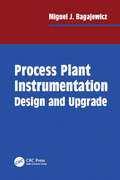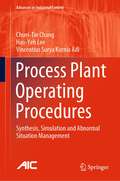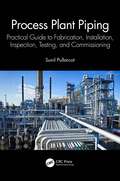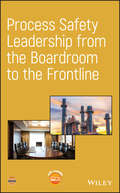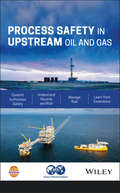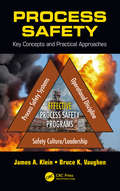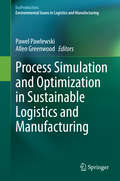- Table View
- List View
Process Management
by Roel in 't Veld Ernst Ten Heuvelhof Hans De BruijnWhat is it that makes a manager or a politician a successful decision maker? Our first inclination would be to say decisiveness and substance. Many managers who met those criteria, however, had to abandon the field in the past several years. The authors of Process Management regard a manager as successful if he pays much attention to the process aspects of change. Successful management depends on the extent to which the
Process Management
by Nadja Damij Talib DamijProcess management affects the functioning of every organization and consequently affects each of us. This book focuses on the multi-disciplinary nature of process management by explaining its theoretical foundations in relation to other areas such as process analysis, knowledge management, and simulation. A crucial linkage between theory and concrete methodology of Tabular Application Development (TAD) is presented as a practical approach consisting of five phases that deal with process identification and modeling, process improvement, development of a process management system and finally - monitoring and maintenance. This book is important for researchers and students of business and management information systems, especially those dealing with courses on process management or related fields. Managers and professionals in process management will also find this book to be useful for their everyday business.
Process Management in Spinning
by R. Senthil KumarA Straightforward Text Summarizing All Aspects of Process ControlTextile manufacturing is one of the largest industries in the world, second only to agriculture. Spinning covers a prominent segment in textile manufacturing, and this budding industry continues to thrive and grow. Process Management in Spinning considers aspect of process management,
Process Mining Techniques for Managing and Improving Healthcare Systems
by Maha ZayoudThis book discusses a new process mining method along with a detailed comparison between different techniques that provide a complete vision of the process of data acquisition, data analysis, and data prediction. Process Mining Techniques for Managing and Improving Healthcare Systems offers a new framework for process learning which is probabilistic and enables the process to be learned in an accumulative manner. The steps of prediction modeling and building the required knowledge are highlighted throughout the book, along with a strong emphasis on the correlation between the healthcare domain and technology including the different aspects, such as: managing records, information, and procedures; early detection of diseases; and the improvement of accuracy in choosing the right treatment procedures. This reference provides a wealth of knowledge for practitioners, researchers, and students at the basic and intermediary levels working within the healthcare system, computer science, electronics and communications, as well as medical providers and also hospital management entities.
Process Mining Techniques for Pattern Recognition: Concepts, Theory, and Practice
by Anil Kumar Dubey Vikash Yadav Erma Suryani Harivans Pratap Singh Gaurav DubeyThis book focuses on the theory, practice, and concepts of process mining techniques in detail, especially pattern recognition in diverse society, science, medicine, engineering, and business. The book deliberates several perspectives on process mining techniques in the broader context of data science and big data approaches. Process Mining Techniques for Pattern Recognition: Concepts, Theory, and Practice provides an introduction to process mining techniques and pattern recognition. After that, it delivers the fundamentals of process modelling and mining essential to comprehend the book. The text emphasizes discovery as an important process mining task and includes case studies as well as real-life examples to guide users in successfully applying process mining techniques for pattern recognition in practice. Intended to be an introduction to process mining and pattern recognition for students, academics, and practitioners, this book is perfect for those who want to learn the basics, and also gain an understanding of the concepts on a deeper level.
Process Mining Techniques in Business Environments
by Andrea BurattinAfter a brief presentation of the state of the art of process-mining techniques, Andrea Burratin proposes different scenarios for the deployment of process-mining projects, and in particular a characterization of companies in terms of their process awareness. The approaches proposed in this book belong to two different computational paradigms: first to classic "batch process mining," and second to more recent "online process mining. " The book encompasses a revised version of the author's PhD thesis, which won the "Best Process Mining Dissertation Award" in 2014, awarded by the IEEE Task Force on Process Mining.
Process Modeling and Simulation for Chemical Engineers: Theory and Practice
by Simant R. UpretiThis book provides a rigorous treatment of the fundamental concepts and techniques involved in process modeling and simulation. The book allows the reader to: (i) Get a solid grasp of “under-the-hood” mathematical results (ii) Develop models of sophisticated processes (iii) Transform models to different geometries and domains as appropriate (iv) Utilize various model simplification techniques (v) Learn simple and effective computational methods for model simulation (vi) Intensify the effectiveness of their research Modeling and Simulation for Chemical Engineers: Theory and Practice begins with an introduction to the terminology of process modeling and simulation. Chapters 2 and 3 cover fundamental and constitutive relations, while Chapter 4 on model formulation builds on these relations. Chapters 5 and 6 introduce the advanced techniques of model transformation and simplification. Chapter 7 deals with model simulation, and the final chapter reviews important mathematical concepts. Presented in a methodical, systematic way, this book is suitable as a self-study guide or as a graduate reference, and includes examples, schematics and diagrams to enrich understanding. End of chapter problems (with solutions and computer software available online) are designed to further stimulate readers to apply the newly-learned concepts. End of chapter problems (with solutions and computer software available online www.wiley.com/go/upreti/pms_for_chemical_engineers) are designed to further stimulate readers to apply the newly learned concepts.
Process Modeling in Composites Manufacturing
by Suresh G. Advani E. Murat SozerThere is a wealth of literature on modeling and simulation of polymer composite manufacturing processes. However, existing books neglect to provide a systematic explanation of how to formulate and apply science-based models in polymer composite manufacturing processes. Process Modeling in Composites Manufacturing, Second Edition provides tangible m
Process Modelling and Simulation in Chemical, Biochemical and Environmental Engineering
by Ashok Kumar VermaThe use of simulation plays a vital part in developing an integrated approach to process design. By helping save time and money before the actual trial of a concept, this practice can assist with troubleshooting, design, control, revamping, and more. Process Modelling and Simulation in Chemical, Biochemical and Environmental Engineering explores ef
Process Monitoring and Fault Diagnosis Based on Multivariable Statistical Analysis (Engineering Applications of Computational Methods #19)
by Xiangyu Kong Jiayu Luo Xiaowei FengThis book reports the developments of the Total Least Square (TLS) algorithms for parameter estimation and adaptive filtering. Specifically, this book introduces the authors’ latest achievements in the past 20 years, including the recursive TLS algorithms, the approximate inverse power iteration TLS algorithm, the neural based MCA algorithm, the neural based SVD algorithm, the neural based TLS algorithm, the TLS algorithms under non-Gaussian noises, performance analysis methods of TLS algorithms, etc. In order to faster the understanding and mastering of the new methods provided by this book for readers, before presenting each new method in each chapter, a specialized section is provided to review the closely related several basis models. Throughout the book, large of procedure of new methods are provided, and all new algorithms or methods proposed by us are tested and verified by numerical simulations or actual engineering applications. Readers will find illustrative demonstration examples on a range of industrial processes to study. Readers will find out the present deficiency and recent developments of the TLS parameter estimation fields, and learn from the the authors’ latest achievements or new methods around the practical industrial needs. In my opinion, this book can be assimilated by advanced undergraduates and graduate (PH.D.) students, as well as statisticians, because of the new tools in data analysis, applied mathematics experts, because of the novel theories and techniques that we propose, engineers, above all for the applications in control, system identification, computer vision, and signal processing.
Process Operational Safety and Cybersecurity: A Feedback Control Approach (Advances in Industrial Control)
by Panagiotis D. Christofides Zhe WuThis book is focused on the development of rigorous, yet practical, methods for the design of advanced process control systems to improve process operational safety and cybersecurity for a wide range of nonlinear process systems. Process Operational Safety and Cybersecurity develops designs for novel model predictive control systems accounting for operational safety considerations, presents theoretical analysis on recursive feasibility and simultaneous closed-loop stability and safety, and discusses practical considerations including data-driven modeling of nonlinear processes, characterization of closed-loop stability regions and computational efficiency. The text then shifts focus to the design of integrated detection and model predictive control systems which improve process cybersecurity by efficiently detecting and mitigating the impact of intelligent cyber-attacks. The book explores several key areas relating to operational safety and cybersecurity including: machine-learning-based modeling of nonlinear dynamical systems for model predictive control;a framework for detection and resilient control of sensor cyber-attacks for nonlinear systems; insight into theoretical and practical issues associated with the design of control systems for process operational safety and cybersecurity; and a number of numerical simulations of chemical process examples and Aspen simulations of large-scale chemical process networks of industrial relevance. A basic knowledge of nonlinear system analysis, Lyapunov stability techniques, dynamic optimization, and machine-learning techniques will help readers to understand the methodologies proposed. The book is a valuable resource for academic researchers and graduate students pursuing research in this area as well as for process control engineers.Advances in Industrial Control reports and encourages the transfer of technology in control engineering. The rapid development of control technology has an impact on all areas of the control discipline. The series offers an opportunity for researchers to present an extended exposition of new work in all aspects of industrial control.
Process Oriented Analysis: Design and Optimization of Industrial Production Systems
by Urs B. Meyer Simone E. Creux Andrea K. Weber MarinIn modern manufacturing, it is not simply the equipment that is increasingly complex but rather the entire business system in which a company operates. Convoluted supply chains, complicated resource flows, advanced information systems: all must be taken into account when designing or reengineering a manufacturing system. Introducing a powerful yet
Process Plant Design
by Robin SmithProcess Plant Design An introductory practical guide to process plant design for students of chemical engineering and practicing chemical engineers. Process Plant Design provides an introductory practical guide to the subject for undergraduate and postgraduate students of chemical engineering, and practicing chemical engineers. Process Plant Design starts by presenting general background from the early stages of chemical process projects and moves on to deal with the infrastructure required to support the operation of process plants. The reliability, maintainability and availability issues addressed in the text are important for process safety, and the avoidance of high maintenance costs, adverse environmental impact, and unnecessary process breakdowns that might prevent production targets being achieved. A practical approach is presented for the systematic synthesis of process control schemes, which has traditionally received little attention, especially when considering overall process control systems. The development of preliminary piping and instrumentation diagrams (P&IDs) is addressed, which are key documents in process engineering. A guide is presented for the choice of materials of construction, which affects resistance to corrosion, mechanical design and the capital cost of equipment. Whilst the final mechanical design of vessels and equipment is normally carried out by specialist mechanical engineers, it is still necessary for process designers to have an understanding of mechanical design for a variety of reasons. Finally, Process Plant Design considers layout, which has important implications for safety, environmental impact, and capital and operating costs. To aid reader comprehension, Process Plant Design features worked examples throughout the text. Process Plant Design is a valuable resource on the subject for advanced undergraduate and postgraduate students of chemical engineering, as well as practicing chemical engineers working in process design. The text is also useful for industrial disciplines related to chemical engineering working on the design of chemical processes.
Process Plant Equipment: Operation, Control, and Reliability
by Oliver A. Onyewuenyi Chikezie Nwaoha Michael Holloway“Process Plant Equipment Book is another great publication from Wiley as a reference book for final year students as well as those who will work or are working in chemical production plants and refinery…” -Associate Prof. Dr. Ramli Mat, Deputy Dean (Academic), Faculty of Chemical Engineering, Universiti Teknologi Malaysia “…give[s] readers access to both fundamental information on process plant equipment and to practical ideas, best practices and experiences of highly successful engineers from around the world… The book is illustrated throughout with numerous black & white photos and diagrams and also contains case studies demonstrating how actual process plants have implemented the tools and techniques discussed in the book. An extensive list of references enables readers to explore each individual topic in greater depth…” –Stainless Steel World and Valve World, November 2012 Discover how to optimize process plant equipment, from selection to operation to troubleshooting From energy to pharmaceuticals to food, the world depends on processing plants to manufacture the products that enable people to survive and flourish. With this book as their guide, readers have the information and practical guidelines needed to select, operate, maintain, control, and troubleshoot process plant equipment so that it is efficient, cost-effective, and reliable throughout its lifetime. Following the authors' careful explanations and instructions, readers will find that they are better able to reduce downtime and unscheduled shutdowns, streamline operations, and maximize the service life of processing equipment. Process Plant Equipment: Operation, Control, and Reliability is divided into three sections: Section One: Process Equipment Operations covers such key equipment as valves, pumps, cooling towers, conveyors, and storage tanks Section Two: Process Plant Reliability sets forth a variety of tested and proven tools and methods to assess and ensure the reliability and mechanical integrity of process equipment, including failure analysis, Fitness-for-Service assessment, engineering economics for chemical processes, and process component function and performance criteria Section Three: Process Measurement, Control, and Modeling examines flow meters, process control, and process modeling and simulation Throughout the book, numerous photos and diagrams illustrate the operation and control of key process equipment. There are also case studies demonstrating how actual process plants have implemented the tools and techniques discussed in the book. At the end of each chapter, an extensive list of references enables readers to explore each individual topic in greater depth. In summary, this text offers students, process engineers, and plant managers the expertise and technical support needed to streamline and optimize the operation of process plant equipment, from its initial selection to operations to troubleshooting.
Process Plant Instrumentation: Design and Upgrade
by Miguel J. BagajewiczThis is the first in-depth presentation in book form of current analytical methods for optimal design, selection and evaluation of instrumentation for process plants. The presentation is clear, concise and systematic-providing process engineers with a valuable tool for improving quality, costs, safety, loss prevention, and production accounting.
Process Plant Operating Procedures: Synthesis, Simulation and Abnormal Situation Management (Advances in Industrial Control)
by Chuei-Tin Chang Hao-Yeh Lee Vincentius Surya AdiProcess Plant Operating Procedures presents an introduction to the theory and applications of procedure synthesis that is primarily concerned with the task of conjecturing the sequence of controller (or operator) actions needed to achieve designated operational goals in a given system. In order to facilitate practical implementation, the formal problem statement, two alternative approaches, their validation methods and a series of realistic examples are provided. The authors explore Petri nets and automata to identify the best paths leading to the specified goal of operation. The model-building methods for characterising all components in the given system, as well as the required control specifications, are explained with simple examples. The sequential control actions and the corresponding time schedule can then be identified accordingly. This book exposes practitioners to an important area of plant operations, teaching them effective approaches for procedure synthesis, enabling them to construct and solve scheduling models, and providing them with tools for simulation and validation of procedures and schedules. It is written for readers with a basic understanding of process design and control activities, and it will appeal to engineers in diverse fields with an interest in synthesizing operating procedures in process plants.Advances in Industrial Control reports and encourages the transfer of technology in control engineering. The rapid development of control technology has an impact on all areas of the control discipline. The series offers an opportunity for researchers to present an extended exposition of new work in all aspects of industrial control.
Process Plant Piping: Practical Guide to Fabrication, Installation, Inspection, Testing, and Commissioning
by Sunil PullarcotThis book is designed as a complete guide to manufacturing, installation, inspection, testing and commissioning of process plant piping. It provides exhaustive coverage of the entire piping spool fabrication, including receiving material inspection at site, material traceability, installation of spools at site, inspection, testing and pre-commissioning activities. In nutshell, it serves as a complete guide to piping fabrication and erection. In addition, typical formats for use in piping fabrication for effective implementation of QA/QC requirements, inspection and test plans, and typical procedures for all types of testing are included. Features: Provides an overview of development of piping documentation in process plant design with number of illustrations Gives exposure to various codes used in piping and pipelines within its jurisdiction Quick reference guide to various applicable sections of ASME B 31.3 provided Coverage of entire construction contractors' scope of work with regard to plant piping Written with special emphasis on practical aspects of construction and final documentation of plant piping for later modifications/investigations This book is aimed at mechanical, process and plant construction engineers/supervisors, specifically as a guide to all novices in the above disciplines.
Process Plants: A Handbook for Inherently Safer Design, Second Edition
by Trevor A. Kletz Paul AmyotteHow far will an ounce of prevention really go? While the answer to that question may never be truly known, Process Plants: A Handbook for Inherently Safer Design, Second Edition takes us several steps closer. The book demonstrates not just the importance of prevention, but the importance of designing with prevention in mind. It emphasizes the role
Process Plants: Shutdown and Turnaround Management
by Trinath SahooWith large amounts of revenue at stake, process industries are focusing more on turnaround management as they strive to lengthen the interval between turnarounds. This book outlines a strategy to execute optimized shutdown and turnaround by changing plant operating conditions and inspection techniques. Because shutdown cost for a petroleum refinery is normally 30 percent higher than annual maintenance costs, this book details how to manage the more favorable turnaround option. The author explores different aspects, including philosophy, planning and scheduling, estimation, contractor management, and execution.
Process Safety Leadership from the Boardroom to the Frontline: Leadership From The Boardroom To The Frontline
by CcpsFor leaders to fulfill their process safety responsibilities, they must demonstrate the same leadership attributes required for success in every other business area. This book discusses how leaders apply these attributes to drive strong process safety cultures and disciplined management systems. Based on benchmarking and broad industrial experience, this groundbreaking book begins by making the “Business Case for Process Safety,” showing the many ways process safety benefits the organization. It then describes essential behaviors and actions for leaders to drive excellence in process safety. Key topics include: Demonstrating process safety leadership; Maintaining management system accountability; Driving culture; Establishing risk criteria and safeguards; Driving operation within constraints; Addressing accidents and near-misses; Ensuring corporate memory; Verifying execution
Process Safety Management: Leveraging Networks and Communities of Practice for Continuous Improvement
by Douglas Evans Ramesh Sharma Chitram Lutchman Rohanie MaharajThe continued prevalence of major incidents (most recently the 2010 BP Gulf of Mexico Oil Spill) and preponderance of workplace fatalities and injuries as well as Process Safety Management (PSM) Incidents, globally, begs the question: why do incidents continue to occur in today's technologically advanced era? More importantly, with 80-85 percent of
Process Safety in Upstream Oil and Gas
by CCPS (Center for Chemical Process Safety)The book makes the case for process safety and provides a brief overviews of the upstream industry and of CCPS Risk Based Process Safety. The majority of the book focuses on the concepts of implementing process safety in wells, onshore, offshore, and projects. Topics include Overview of Upstream Operations; Overview of Risk Based Process Safety (RBPS); Application of RBPS in Drilling, Completions, Work-Overs & Interventions, Application of RBPS in Onshore Production, Application of RBPS in Offshore Production, Application of RBPS to Engineering Design, Installation, and Construction, Future Developments in the Field
Process Safety: Key Concepts and Practical Approaches
by James A. Klein Bruce K. VaughenEffective process safety programs consist of three interrelated foundations—safety culture and leadership, process safety systems, and operational discipline—designed to prevent serious injuries and incidents resulting from toxic releases, fires, explosions, and uncontrolled reactions. Each of these foundations is important and one missing element can cause poor process safety performance. Process Safety: Key Concepts and Practical Approaches takes a systemic approach to the traditional process safety elements that have been identified for effective process safety programs. More effective process safety risk reduction efforts are achieved when these process safety systems, based on desired activities and results rather than by specific elements, are integrated and organized in a systems framework. This book provides key concepts, practical approaches, and tools for establishing and maintaining effective process safety programs to successfully identify, evaluate, and manage process hazards. It introduces process safety systems in a way that helps readers understand the purpose, design, and everyday use of overall process safety system requirements. Understanding what the systems are intended to achieve, understanding why they have been designed and implemented in a specific way, and understanding how they should function day-to-day is essential to ensure continued safe and reliable operations.
Process Simulation Using WITNESS
by Raid Al-Aomar Edward J. Williams Onur M. UlgenTeaches basic and advanced modeling and simulation techniques to both undergraduate and postgraduate students and serves as a practical guide and manual for professionals learning how to build simulation models using WITNESS, a free-standing software package. This book discusses the theory behind simulation and demonstrates how to build simulation models with WITNESS. The book begins with an explanation of the concepts of simulation modeling and a "guided tour" of the WITNESS modeling environment. Next, the authors cover the basics of building simulation models using WITNESS and modeling of material-handling systems. After taking a brief tour in basic probability and statistics, simulation model input analysis is then examined in detail, including the importance and techniques of fitting closed-form distributions to observed data. Next, the authors present simulation output analysis including determining run controls and statistical analysis of simulation outputs and show how to use these techniques and others to undertake simulation model verification and validation. Effective techniques for managing a simulation project are analyzed, and case studies exemplifying the use of simulation in manufacturing and services are covered. Simulation-based optimization methods and the use of simulation to build and enhance lean systems are then discussed. Finally, the authors examine the interrelationships and synergy between simulation and Six Sigma. Emphasizes real-world applications of simulation modeling in both services and manufacturing sectors Discusses the role of simulation in Six Sigma projects and Lean Systems Contains examples in each chapter on the methods and concepts presented Process Simulation Using WITNESS is a resource for students, researchers, engineers, management consultants, and simulation trainers.
Process Simulation and Optimization in Sustainable Logistics and Manufacturing
by Pawel Pawlewski Allen GreenwoodThe aim of this book is to present qualitative aspects of logistics operations and supply chain management which help to implement the sustainable policy principles in the companies and public sector's institutions. Authors in individual chapters address the issues related to reverse network configuration, forward and reverse supply chain integration, CO2 reduction in transportation, improvement of the production operations and management of the recovery activities. Some best practices from different countries and industries are presented. This book will be valuable to both academics and practitioners wishing to deepen their knowledge in the field of logistics operations and management with regard to sustainability issues.

